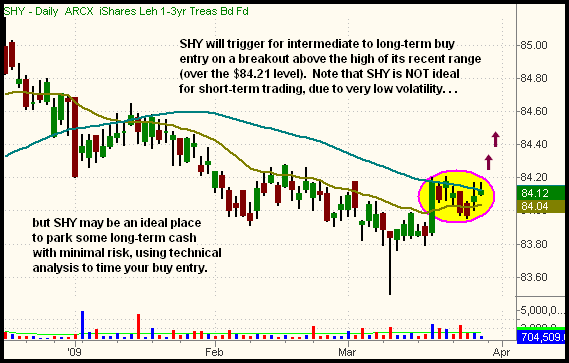|
The Wagner Daily ETF Report For March 30
Stocks concluded the week on a negative note, as the major indices gave back a majority of the previous day's large gains. Nevertheless, the broad market still advanced for the third straight week. Last Friday, the Dow Jones Industrial Average lost 1.9%, the S&P 500 2.0%, and the Nasdaq Composite 2.6%. The small-cap Russell 2000 shed 3.7% and the S&P Midcap 400 fell 2.5%. Most of the day's decline was the result of an opening gap down, as stocks subsequently traded in a tight, sideways range, all the way into the closing bell. For the week, the Dow Jones Industrials climbed 6.8%, the S&P 500 6.2%, and the Nasdaq Composite 6%.
Lighter turnover accompanied last Friday's losses, easing the sting of the decline. Total volume in the NYSE receded 20%, while volume in the Nasdaq was 18% lighter than the previous day's level. The substantially slower pace of trading was positive, as it indicated mutual funds, hedge funds, and other institutions were not active participants in the selling. Still, market internals were firmly negative. In the NYSE, declining volume exceeded advancing volume by a margin of 7 to 1. The Nasdaq adv/dec volume ratio was negative by 3 to 1.
If you're concerned about initiating new long positions at current levels, you may want to check out some of the fixed-income (bond) ETFs. Not only do treasury bonds offer a relatively safe place to park cash, but technical analysis can also be used to time a buy entry in which, in addition to monthly dividend distributions, capital gains are most likely to be realized as well. Check out the daily chart of the iShares 1-3 year (short-term) Treasury Bond (SHY):

Circled in pink, notice how SHY has been consolidating right at resistance of its 50-day moving average. In the coming days, we anticipate a breakout above the high of its recent range ($84.21), which will enable SHY to move back above its 50-day MA as well. That would be a logical place to initiate a new buy entry for an intermediate to long-term hold in the treasury bond markets.
Because SHY has a very low volatility (it has traded in a range of just one point all year), it is not advisable to treat this as a short-term trade. There simply isn't enough beta to turn a decent profit. However, when viewed as a long-term trade, perhaps in an IRA account, one additionally benefits from the major advantage of bond ETFs -- regular dividend distributions. Over the past year, for example, SHY has paid monthly to bi-monthly dividends, averaging approximately 25 cents per share, which adds up in the long term. But if you're looking to profit from short-term trading of the bond ETFs, consider the iShares 20+ year (long-term) Treasury Bonds (TLT) instead, as it has a much wider trading range. For a list of all the other bond ETFs (with an average daily volume greater than 50,000 shares) download our free Morpheus ETF Roundup.
In our March 27 commentary, we said, "Though the broad market remains in both short and intermediate-term uptrends, resistance of the Nasdaq's February highs means it may be a good idea to consider just one or two short positions (or inverse ETFs) near current levels, especially if you're now heavily positioned on the long side of the market. Trailing tight stops on winning long positions isn't a bad idea either." Given last Friday's losses, as well as the S&P and Nasdaq cash futures indication of a sharply lower open to Monday's session, the market seems to be confirming our suggestion. Yet, since the Nasdaq reversed before actually touching its February high, there still may be one more upward thrust, to sucker in a few more bulls, before the market pulls back much further. But if last Friday's weakness continues straight into today's session, keep a close eye on whether or not the main stock market indexes manage to hold new support of their 50-day moving averages (792 for S&P 500, 1,463 for Nasdaq Composite, and 7,597 for the Dow).
Last Friday's setup to buy UltraShort Financial ProShares (SKF) did not yet trade through our trigger price, but will likely do so today. Depending on how high it gaps on the open, we may buy the inversely correlated SKF on a breakout above last Friday's high (and the 20-EMA/60 minute). But because it was intended to be a quick, momentum-driven bounce play, we need to be sure the risk-reward ratio of the setup is not too negatively skewed if SKF opens too much higher than Friday's close.
Open ETF positions:
Long - UGA, USO, SLV, HHH, UDN
Short - (none)
Deron Wagner is the Founder and Head Trader of both Morpheus Capital LP, a U.S. hedge fund, and Morpheus Trading Group, a trader education firm launched in 2001 that provides daily technical analysis of the leading ETFs and stocks. For a free trial to the full version of The Wagner Daily or to learn about Wagner's other services, visit MorpheusTrading.com or send an e-mail to deron@morpheustrading.com.
|